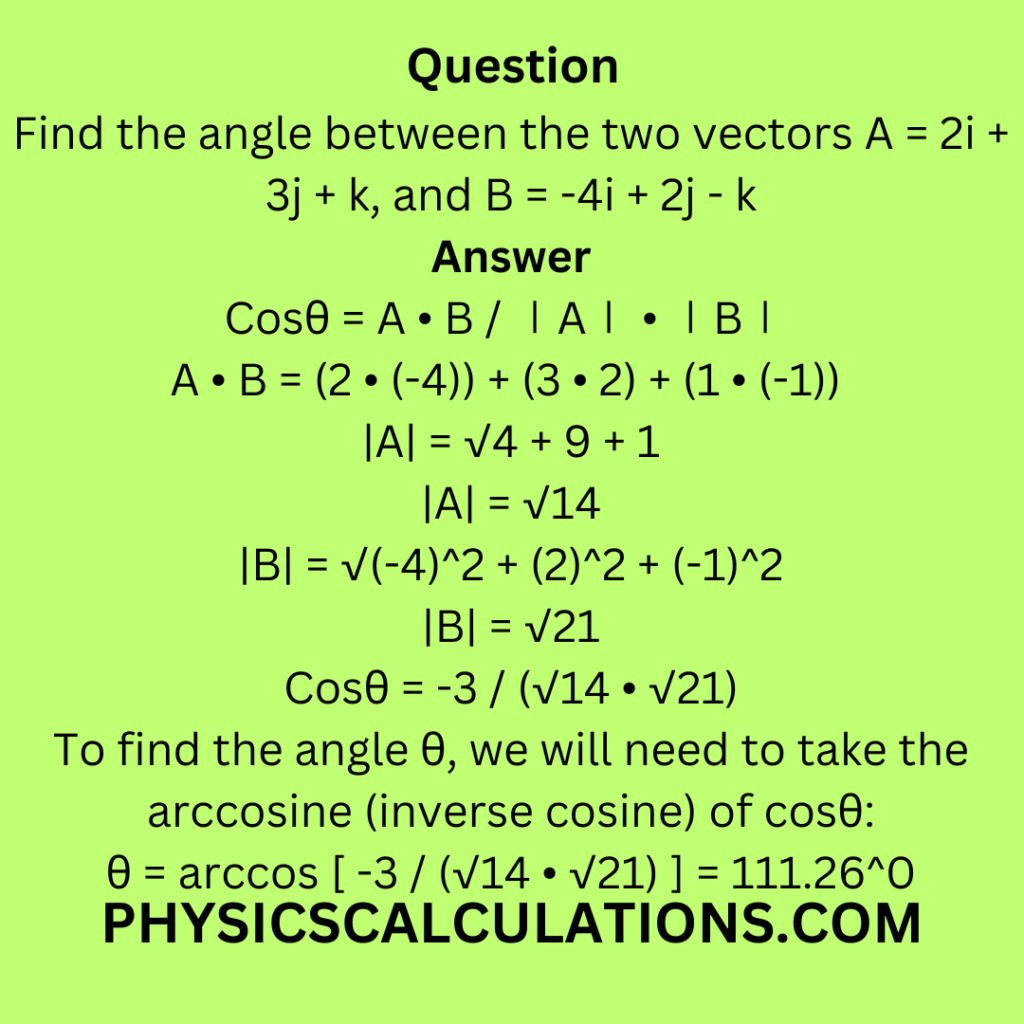Question
Find the angle between the two vectors A = 2i + 3j + k, and B = -4i + 2j – k
Answer

The angle between the two vectors A and B, given as (2i + 3j + k) and (-4i + 2j – k), respectively, is approximately 111.260. This angle is found using the formula for the cosine of the angle between vectors, taking into account the scalar (dot) product of the vectors and their magnitudes. Below is a detail explanation of how we arrived at the final answer.
Our objective is to find the angle between two vectors, A and B, where the vectors are given in component form.
Data:
We are provided with two vectors:
- Vector (A) = (2i + 3j + k)
- Vector (B) = (-4i + 2j – k)
Unknown:
We need to find the angle θ between the two vectors A and B = ?
Formula:
To solve this problem, we will use the formula for the angle θ between two vectors A and B:
Cosθ = A • B / ∣A∣ • ∣B∣
Where:
- A • B is the scalar (dot) product of vectors A and B.
- |A| and |B| are the magnitudes of vectors A and B.
- Cosθ is the cosine of the angle between the two vectors.
You may also like to read:
Find the scalar product A • B of the two vectors. The magnitude of the vectors are A = 4.00
Solution:
First Step:
We will now start by identifying the given data:
- Vector A = (2i + 3j + k)
- Vector B = (-4i + 2j – k)
Second Step:
Now, we can use the formula to find the cosine of the angle between the vectors:
Cosθ = A • B / ∣A∣ • ∣B∣
Third Step:
We will start by calculating the scalar product A • B. This involves taking the dot product of the components of the vectors A and B:
A • B = (2 • (-4)) + (3 • 2) + (1 • (-1))
The above equation will now give us: A • B = (-8) + (6) + (-1)
A • B = -1
Fourth Step:
Next, we need to calculate the magnitudes of the vectors A and B. The magnitude of a vector V = ai + bj + ck can be found using the formula:
|V| = √(a2 + b2 + c2)
For vector (A):
|A| = √(2)2 + (3)2 + (1)2
We will now have
|A| = √4 + 9 + 1
Therefore
|A| = √14
For vector B:
|B| = √(-4)2 + (2)2 + (-1)2
Hence,
|B| = √21
Fifth Step:
Now, we can calculate the cosine of the angle cosθ using the formula:
Cosθ = A • B / ∣A∣ • ∣B∣
Cosθ = -3 / (√14 • √21)
Sixth Step:
To find the angle θ, we will need to take the arccosine (inverse cosine) of cosθ:
θ = arccos [ -3 / (√14 • √21) ]
Seventh Step:
Calculate the value of θ:
θ = arccos [ -3 / (√14 • √21) ] = 111.260
Explanation:
In this case, the vectors A and B are not aligned or antiparallel (180 degrees), but they form an angle of approximately 111.26 degrees. This angle provides information about the relative orientation of the two vectors in space.
Understanding the angle between vectors is fundamental in physics, as it helps analyze the direction of physical quantities like forces, velocities, and displacements in various contexts, including mechanics, electromagnetism, and more.
In summary, the angle θ between the vectors A and B is approximately 111.260, calculated using the dot product and the magnitudes of the vectors. This angle represents the angular separation between the two vectors in a three-dimensional space.